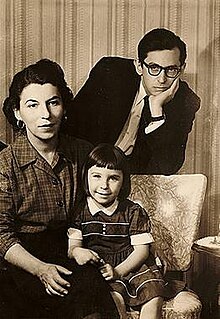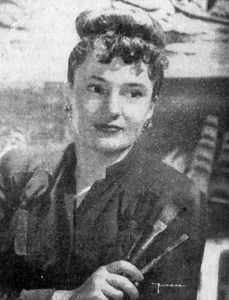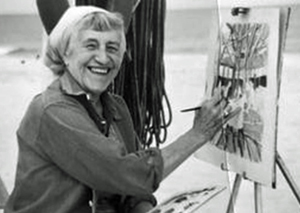Marion Huse (1896-1967) was an American artist, known for painting and printmaking
Marion Huse (1896-1967) was an American artist, known for painting and printmaking
Huse was born in 1896 in Lynn, Massachusetts. [1] She studied at the New School of Design in Boston and the Carnegie Institute of Art and Technology. [2]
Huse ran the Springfield Art School in Massachusetts from 1925 through 1940. In the 1930s she worked as an artist for the Works Progress Administration [3] eventually becoming supervisor for the western part of Vermont. [4] She was married to Robert Barstow and led a peripatetic life, traveling around the United States and Europe. [4] [5]
Huse was included in the 1947 and 1951 Dallas Museum of Fine Arts exhibitions of the National Serigraph Society. [6] [7]
Her work is included in the collections of the Fuller Museum of Art, the Library of Congress, the Museum of Fine Arts, Boston, and the Victoria and Albert Museum. [4]
Huse died in 1967. [2] Her papers are in the Archives of American Art at the Smithsonian Institution. [5]

William McGregor Paxton was an American painter and instructor who embraced the Boston School paradigm and was a co-founder of The Guild of Boston Artists. He taught briefly while a student at Cowles Art School, where he met his wife Elizabeth Okie Paxton, and at the Museum of Fine Arts School in Boston. Paxton is known for his portraits, including those of two presidents—Grover Cleveland and Calvin Coolidge—and interior scenes with women, including his wife. His works are in many museums in the United States.
Harry Shoulberg was an American expressionist painter. He was known to be among the early group of WPA artists working in the screen print (serigraph) medium, as well as oil.
Anne Ryan (1889–1954) belonged to the early generation of New York School Abstract Expressionist artists. Her first contact with the New York Avant-garde came in 1941 when she joined the Atelier 17, a famous printmaking workshop that the British artist Stanley William Hayter had established in Paris in the 1930s and then brought to New York when France fell to the Nazis. The great turning point in Anne Ryan's development occurred after the war, in 1948. She was 57 years old when she saw the collages of Kurt Schwitters at the Rose Fried Gallery, in New York City, in 1948. She right away dedicated herself to this newly discovered medium. Since Anne Ryan was a poet, according to Deborah Solomon, in Kurt Schwitters’s collages “she recognized the visual equivalent of her sonnets – discrete images packed together in an extremely compressed space.” When six years later Anne Ryan died, her work in this medium numbered over 400 pieces.
Peter Grippe was an American sculptor, printmaker, and painter. As a sculptor, he worked in bronze, terracotta, wire, plaster, and found objects. His "Monument to Hiroshima" series (1963) used found objects cast in bronze sculptures to evoke the chaotic humanity of the Japanese city after its incineration by atomic bomb. Other Grippe Surrealist sculptural works address less warlike themes, including that of city life. However, his expertise extended beyond sculpture to ink drawings, watercolor painting, and printmaking (intaglio). He joined and later directed Atelier 17, the intaglio studio founded in London and moved to New York at the beginning of World War II by its founder, Stanley William Hayter. Today, Grippe's 21 Etchings and Poems, a part of the permanent collection at the Davis Museum and Cultural Center at Wellesley College in Wellesley, Massachusetts, is available as part of the museum's virtual collection.

Ruth Gikow was an American visual artist known primarily for her work as a genre painter. Her paintings often depict human figures interacting with an urban environment.
Riva Helfond was an American artist and printmaker best known for her social realist studies of working people's lives.

Dora Deborah Kaminsky was an American artist.

Marion Osborn Cunningham was an American artist.

Ruth Starr Rose (1887–1965) was an American artist, lithographer and serigrapher best known for her paintings of African American life in Maryland in the 1930s and 1940s. This important woman artist's work is now touring throughout Maryland, the United States, and Europe as a unique example of an early American Shared Community expressed through pigment and paint. Additionally, Rose is credited as the first white artist to create a work of art for a black church. The subject of her fresco, Pharaoh's Army Got Drownded, was to honor the minister's son who perished in training for WWII.
Bernece Berkman (1911–1988), known as Bernece Berkman-Hunter after marriage, was an American painter born in Chicago, Illinois. She was inspired by what she saw in urban Chicago during the Great Depression and is best known for paintings depicting the plight of industrial workers and the poor.

Beatrice Mandelman, known as Bea, was an American abstract artist associated with the group known as the Taos Moderns. She was born in Newark, New Jersey to Anna Lisker Mandelman and Louis Mandelman, Jewish immigrants who imbued their children with their social justice values and love of the arts. After studying art in New York City and being employed by the Works Progress Administration Federal Arts Project (WPA-FAP), Mandelman arrived in Taos, New Mexico, with her artist husband Louis Leon Ribak in 1944 at the age of 32. Mandelman's oeuvre consisted mainly of paintings, prints, and collages. Much of her work was highly abstract, including her representational pieces such as cityscapes, landscapes, and still lifes. Through the 1940s, her paintings feature richly textured surfaces and a subtly modulated, often subdued color palette. New Mexico landscape and culture had a profound influence on Mandelman's style, influencing it towards a brighter palette, more geometric forms, flatter surfaces, and more crisply defined forms. One critic wrote that the "twin poles" of her work were Cubism and Expressionism. Her work is included in many major public collections, including large holdings at the University of New Mexico Art Museum and Harwood Museum of Art.

Ture Bengtz (1907-1973) was a Finnish-American artist associated with the Boston Expressionist school, an influential teacher at the School of the Museum of Fine Arts in Boston, and director of the Art Complex Museum in Duxbury, Massachusetts. He also had a television show, "Bengtz on Drawing," on Boston's PBS station in the late 1950s.
Ruth Chaney (1908-1973) was an American artist known for her printmaking.
Louise Arnstein Freedman was an American artist, known for illustration, lithography and serigraphy.

Gladys M. Lux (1899-2003) was an American artist and educator, known for painting and printmaking
Doris Meltzer (1908-1977) was an American artist and art dealer.

Mildred Rackley (1906-1992) was an American artist known for her printmaking. She is also known for her work in medical services in Spain during the Spanish Civil War.
Mary Van Blarcom (1913–1953) was an American artist known for her printmaking.

Francine Felsenthal was an American artist. She also used the name Francine L. Fels.